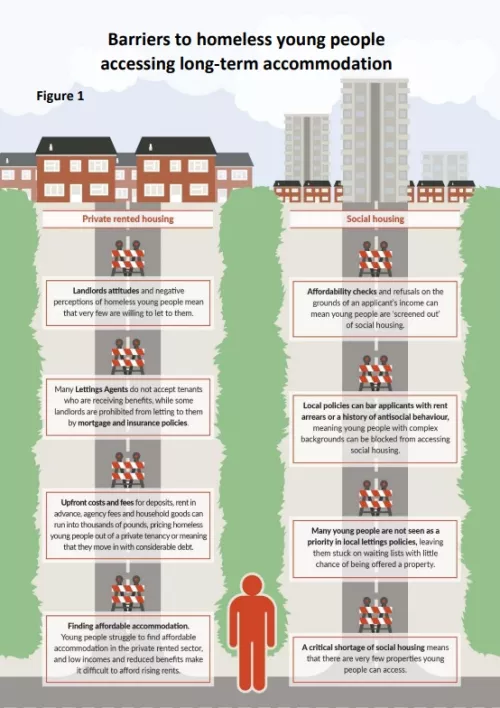Centrepoint is calling on London Mayoral candidates to commit to taking urgent action on youth homelessness.
In 2017-18 an estimated 12,200 under 25s asked their London council for help because they were homeless or at risk of homelessness.
The Mayor of London has significant powers to tackle youth homelessness. By investing in young Londoners, the Mayor can secure a safe and positive future for our city.
Manifesto for Homeless Young People
The next Mayor of London should:
- Set aside £20 million to deliver move-on accommodation specifically for young people leaving supported accommodation and ready for independent living.
- Ensure that the Mayor’s London Housing Strategy prioritises high-quality floating support for young people moving on from homelessness.
- Establish rent deposit schemes for care leavers across London. Some landlords require a deposit and rent upfront, which is especially difficult for care leavers who do not have financial support from family.
- Better promote traineeships to provide under 25s with on-the-job training that acts as an important stepping stone towards further education, employment and training.
- Fund a range of youth services and facilities, including education, sport and cultural activities. This is particularly important to reduce the risk of young people getting caught up in crime.
- As the Police and Crime Commissioner, work with the Metropolitan Police to introduce a ‘commitment to refer’ under the Homelessness Reduction Act (2017). This would commit police officers to formally refer people experiencing or at risk of homelessness to their local authority for support.

The “Six to Fix” Mayoral Plan
- Set aside £20 million to deliver move-on accommodation specifically for young people leaving supported accommodation.
When young people are ready to move on from supported accommodation they face a range of barriers which make it difficult to find suitable long-term accommodation (see figure 1). This can have damaging effects on young people’s wellbeing, development and progress towards independence.
A Centrepoint survey found that only 21 per cent of private sector landlords are willing to let to a young person leaving supported accommodation.i Furthermore, due to high demand for social housing, young people on low incomes are increasingly ‘screened out’ by affordability checks. The Mayor’s office must work with private and social landlords to address these barriers. Centrepoint is calling on the Mayor to set aside £20 million to meet demand for move-on accommodation for young people.
Over 40 per cent of people living in supported accommodation are under 25; without targeted support to move on positively, they risk falling into a cycle of homelessness. - Ensure that the Mayor’s London Housing Strategy prioritises high-quality floating support for young people who have experienced homelessness.
Floating support is critical to prevent repeat homelessness. A trusted professional can help a young person to sustain their tenancy and remain in employment or education. This source of support and advice reduces social exclusion, relieves feelings of loneliness and safeguards vulnerable young people in their own accommodation. - Establish rent deposit schemes for care leavers across London.
Some landlords require a deposit and rent upfront, which is especially difficult for care leavers who do not have financial support from family.40 per cent of care leavers surveyed by Centrepoint said they did not have enough savings for a rental deposit (see figure 2). Councils like Croydon are already offering care leavers a month’s rent in advance and a deposit, but this is not guaranteed. The Mayor’s office must use its influence to ensure local authorities fulfil their corporate parenting responsibilities. - Better promote traineeships to provide under 25s with on-the-job training that acts as an important stepping stone towards further education, employment and training.
Traineeships give under 25s the chance to gain the skills and qualifications they need. They are of particular benefit to young people from disadvantaged backgrounds, who may otherwise have limited opportunities to gain such experiences. As Chair of the London Economic Action Partnership, the Mayor can help employers to better understand the value of traineeships. - Fund local authorities to provide a range of youth services and facilities, including education, sport and cultural activities.
A Youth Violence Commission survey found that the provision of ‘more youth centres, sports clubs and other youth activities’ would help young people to feel safer in their local area.
Since 2011, at least 100 youth centres have closed in London.vi This has resulted in a loss of space for recreation and socialising, as well as opportunities for young people to engage with trusted professionals.
Initiatives like the Mayor’s Young Londoners Fund are vital and should be expanded to reach more young people. - Work with the Metropolitan Police to introduce a ‘commitment to refer’ people experiencing or at risk of homelessness to their local authority for support.
The Homelessness Reduction Act 2017 created a wide ranging ‘duty to refer’ for public services. However several key agencies were omitted from the duty, including the police. With considerable overlap between involvement in criminal activity and housing instability for young people, there is a clear case for the police taking a greater role in responding to homelessness, initially through a ‘commitment to refer’ those without any stable accommodation to their local authority.
References:
- Centrepoint, “Ready to Move On: Barriers to homeless young people accessing accommodation.” (2018)
- Homeless Link’s annual review (2017).
- Centrepoint, “From Care to Where? Care leavers’ access to accommodation” (2017)
- Croydon Council, “Local Offer for Care Leavers” (2018)
- The Youth Violence Commission survey of over 2,200 young people (2018)
- Sian Berry AM, “London’s Lost Youth Services” (2019)
Download the policy briefing
Download the information on this page in PDF format.
